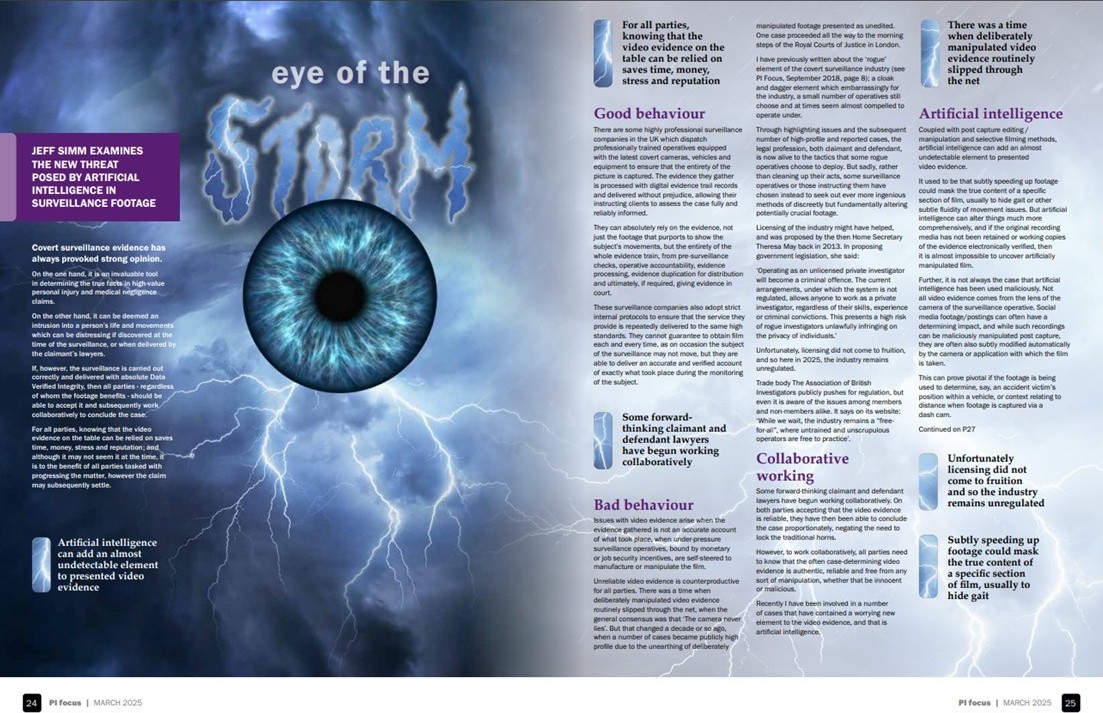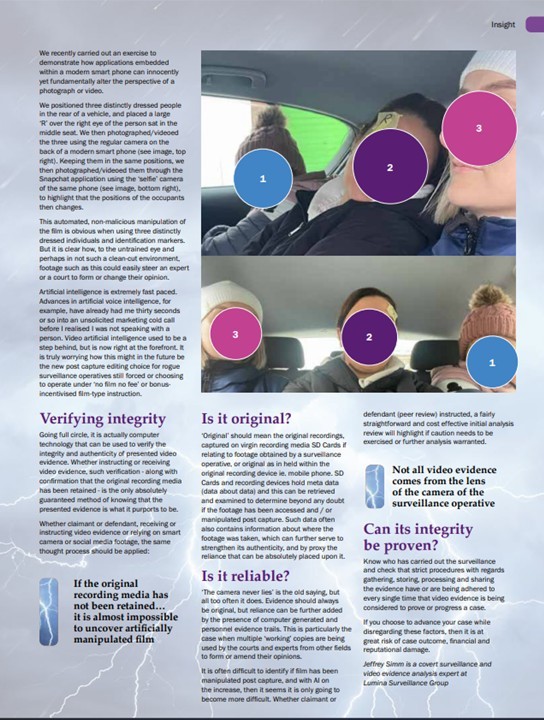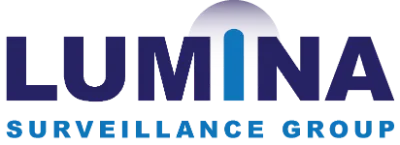For those who missed the March edition of APIL’s PI Focus publication, here is the full cover-article from Lumina Surveillance Group entitled: ‘The threat of AI manipulation in video surveillance footage’
Jeff Simm examines the new threat posted by artificial intelligence in surveillance footage.
Covert surveillance evidence has always provoked strong opinion.
On the one hand, it is an invaluable tool in determining the true facts in high-value personal injury and medical negligence claims.
On the other hand, it can be deemed an intrusion into a person’s life and movements which can be distressing if discovered at the time of the surveillance, or when delivered by the claimant’s lawyers.
If, however, the surveillance is carried out correctly and delivered with absolute Data Verified Integrity, then all parties – regardless of who the footage benefits – should be able to accept it and subsequently work collaboratively to achieve the case’s end.
For all parties, knowing that the video evidence on the table can be relied on saves time, money, stress and reputation, and although it may not seem it at the time, it is to the benefit of all parties tasked with progressing the matter, whatever the claim may subsequently settle.
Artificial intelligence can add an almost undetectable element to presented video evidence
For all parties, knowing that the video evidence on the table can be relied on saves time, money, stress and reputation
Good behaviour
There are some highly professional surveillance companies in the UK which dispatch professionally trained operatives equipped with the latest covert cameras, vehicles and equipment to ensure that the entirety of the picture is captured. The evidence they record is delivered with digital production trackers and delivered with evidence, allowing the instructing clients to assess the case fully and reliably informed.
They can absolutely rely on the evidence, not just the footage that purports to show the subject’s movements, but the entirety of the whole evidence train, from pre-surveillance choices, operative accountability, evidence processing, evidence duplication (for distribution and ultimately, if required, giving evidence in court.
These surveillance companies also adopt strict internal protocols to ensure that the sample they provide is repeatedly delivered to the above high standards. They cannot guarantee the subject or each surveillance, as no case is the same. But what they can ensure on most occasions is that the evidence is both accurate and verified, accounting for exactly what took place during the monitoring of the subject.
Some forward-thinking claimant and defendant lawyers have begun working collaboratively
Bad behaviour
Issues with video evidence arise when the evidence gathered is not an accurate account of what took place, whether by unintentional actions of agents and subsequently misrepresentation, or deliberate actions of the surveillance manufacturer to manipulate the film.
Unreliable surveillance is a counterproductive tool for all parties involved. Time and evidence are misplaced through what is, even when not intentionally manipulated, the weakest of signals. But all that changed because of years gone by when countless cases had the profile due to the uncovering of deliberately manipulated footage presented as unedited. One case proceeded all the way to the morning steps of the Royal Courts of Justice in London.
I have previously written about the ‘rogue’ element of the covert surveillance industry (see PI Focus, September 2018, page 8); it is back in the industry and is still ever present despite the closure, arrest and number of companies not choosing it, and in similar situations all too common over the years.
Number of high-profile, rogue cases resulted in huge reputational damage for the instructing parties and even the law firms themselves. These were the days when a surveillance operator chose to deliberately manipulate the evidence, whether that be by selectively editing, cutting footage, inserting a completely different person, or, as was commonly the method, subtly speeding up footage, methods of discreetly but fundamentally altering potentially crucial footage.
There was a time when deliberately manipulated video evidence routinely slipped through the net
Collaborative working
Some forward-thinking claimant and defendant lawyers have begun working collaboratively. On several high-value claims, instructing parties have agreed to meet together to review the surveillance evidence, as an opportunity for both sides to see the full footage, with all parties in attendance. They are in a much better position to either settle the claim or agree on how the evidence will be presented in court.
Artificial intelligence
Couple with covert photographic editing methods, manipulation and the introduction of new threats, artificial intelligence (AI) can now add an almost undetectable element to presented video evidence.
The technology that has subtly sped up footage to mask the true content of a specific section of film, usually to hide gait, can now be made even more sophisticated by AI.
AI is now able to completely manipulate surveillance evidence, meaning that those working in the industry must be more diligent and informed than ever before.
Worryingly, the latest Government consultation on video evidence, led by then Home Secretary Theresa May back in 2013, in response to the News of the World phone hacking scandal, and subsequent Leveson Inquiry, has not been updated to reflect the threat that AI now poses.
Furthermore, it has not covered artificial intelligence. At present, there is no agreed licensing or regulation for video evidence provided by private surveillance companies, nor for the editing or manipulation of such evidence. Unlicensed, unregulated companies could easily operate and supply footage to solicitors, insurance companies, and the police as part of litigation without any guarantee or obligation that the footage is being delivered in a complete or verified way.
So clients need to ask the correct questions to be satisfied that the footage is original with a chain of custody, as to how the footage was captured via a professional process.
Unfortunately licensing did not come to fruition and so the industry remains unregulated
Subtly speeding up footage could mask the true content of a specific section of film, usually to hide gait
We recently carried out an exercise to demonstrate how applications embedded within a modern smart phone can innocently yet fundamentally alter the perspective of a photograph or video.
We positioned three distinctly dressed people in the rear seat of a vehicle, and placed a tiny video camera at the right of the seat and in the middle seat. We then photographed/videoed the three using the regular camera on a phone, and again using the same phone with the ‘super wide’ (panoramic) image setting. The ‘super wide’ photograph/video then puts the two end seat occupants in the same position, whilst the person photographed/videoed nearest the camera is enlarged (see photo shown). The image has then shifted the positions of the occupants to alternate places.
This automated, non-malicious manipulation of the film is obvious when using three distinctly dressed individuals and identification markers. But it is clear how, to the untrained eye and perhaps rushed hands, such a casual extension of footage as such is so easily either sent to an expert, or a court to form or change their opinion.
Artificial intelligence is extremely fast paced. Advances in artificial video intelligence, for example, have already made thirty seconds of human run analysis with the fifty controls previously built into covert and editing tools as rapid as one. Unsuspecting recipients, such as law firms and insurance agencies, might have been a step behind, but is now right at the forefront. It is probably unavoidable that evidence from future surveillance operations sits on the horizon to open user operatives into the potential of choosing to optimise applications for use or for re-issue with identified ‘time-po’ film footage.
Verifying integrity
Going full circle, it is actually computer technology that can be used to verify the authenticity and absolute continuity of surveillance footage and recordings. With sufficient understanding of reviewing original media, checksums, watermarking and associated techniques, a technical reviewer should be able to establish whether a film has been tampered with or edited. In my opinion, if the original recording media has not been retained, it is almost impossible to uncover artificially manipulated film.
If the original recording media has not been retained… it is almost impossible to uncover artificially manipulated film
Is it original?
‘Original’ should mean the original recordings, captured on original recording media (SD Cards if relating to video when recorded by a surveillance operative). With the multitude of mobile phone cameras and the possibility that the original SD card is overwritten, the chance of retaining original media diminishes with time. SO only original recording media should be sought, not copies, not re-processed files, but the actual original file, which will have identifying features as to date and time of capture, device used and so on. This file, when technically examined, will have features that substantiate or prove authenticity.
If these files are not available, any evidence should be viewed with an abundance of caution by the instructing party.
Is it reliable?
The camera never lies’ is the old saying, but as demonstrated here, even the subtlest change alters the facts. Evidence should always be scrutinised, even if being obtained by an independent third party. Instructing parties should be clear with surveillance operatives on exactly what they require, and how they expect to receive it. If any doubt exists, an independent expert should be consulted to report on the authenticity and reliability of the evidence. The process is usually relatively straightforward, but with the use of ever more sophisticated technology it can only become more difficult. Whether claimant or defendant (peer review) instructed, a fairly straightforward and cost-effective initial analysis and highlight if caution needs to be exercised or further analysis warranted.
Not all video evidence comes from the lens of the camera of the surveillance operative
Can its integrity be proven?
Know who is conducting the surveillance and what is being recorded, what equipment is being used, what the protocol is for providing the evidence, and what the chain of custody is for the original files.
This will allow parties to reach an early decision on whether surveillance is helpful, reliable, and can be relied on to inform the case outcome. Failure to do so could have the reverse effect.
Jeffrey Simm is a covert surveillance and intelligence consultant at Lumina Surveillance Group



